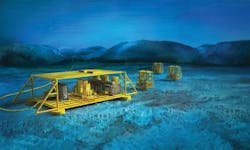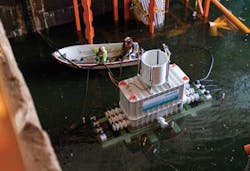Subsea power grid accelerating transfer of topsides functions to seafloor
Jeremy Beckman
Editor, Europe
Siemens is close to completing an initial test program on the four main components (subsea transformer, subsea medium-voltage (MV) Switchgear, subsea variable speed drive, and subsea power control and communication system) of a proposed subsea power distribution hub. The Subsea Power Grid will be connected on the seafloor to the array of new equipment emerging for subsea production, processing and boosting. This should facilitate expansion of field development into deeper water, longer step-outs, and more demanding production environments.
Design of the grid's subsea transformer, switchgear and variable-speed drives (VSDs), as well as the communication and control system started in 2010. The subsequent engineering/test campaign has been conducted mainly at Siemens' Subsea Technology Center in Trondheim, Norway, since it was opened in September 2011, in co-operation with Siemens locations in other countries. The 10,000-sq m (107,639-sq ft) facility in Trondheim includes a pressure test laboratory that can simulate ultra-deepwater conditions (up to 460 bar/6,672 psi) in 23 pressure vessels of different sizes. Initial testing of the individual Subsea Power Grid (SPG) component prototypes is nearing completion, and will be followed next year by extended shallow-water trials of the integrated SPG in Trondheim harbor. One of the goals is to ensure that the system can remain in operation on the seafloor for many years, without maintenance.
The development, testing, and qualification program is supported by Chevron, ExxonMobil, Petrobras, and Statoil, all noted for pushing the boundaries ofsubsea and deepwater production. The technologies they and other operators are looking to transfer to the seabed include gas compression, water injection, multi-phase booster pumps, and subsea separation. According to Subsea Technology Center director Jan Erik Lystad, "oil companies have been telling us that they need more power to be distributed to multiple subsea consumers in order to reach out further to access more reservoir pockets."
"Current technology can transmit only limited amounts of power to the seabed, which does not allow connections to multiple equipment items, or 'consumers,' in an effective manner," Lystad explained. "When each subsea consumer has to be connected to topside power distribution equipment via individual subsea cables this requires a lot of topside space and riser capacity. That makes the operation both complex and costly, and it is not a viable solution for long step-outs, for a large number of consumers, or for high-power requirements."
"By implementing a subsea power hub and grid, operators of subsea fields will be able to distribute power more widely," Lystad noted. "In addition, the subsea power supply and distribution system eliminates a lot of complexity. With the Subsea Power Grid, there is just one high voltage (typically up to 100 kV) cable running from the surface to the seabed to a subsea step-down transformer in the hub, where voltage will be reduced to 36 kV. Then the power is distributed through a medium-voltage switchgear (one switch per consumer) and on to individual variable-speed drives for each pump, compressor, and so on."
In addition to reducing cable volume, the Subsea Power Grid should enable increased use of boosting closer to wells, Lystad claimed. "This will allow new alternative and less complex field development solutions that are economically superior to current platform/tieback concepts. It will also open up development of reserves to be developed in remoter regions, i.e. beneath Arctic ice."
"There are physical limits regarding the length of subsea step-outs that the subsea grid can supply. The industry is talking in terms of step-outs of 200 km (124 mi) or more, but achieving this will depend on the type of equipment that needs to be connected and the total power rating for the distribution."
Interface potential
Siemens' Subsea Power Grid is intended to be a comprehensive power supply and distribution system containing transformers, switchgear and VSDs, and a fully redundant communication/control system, delivering power at customer-specified rates to various subsea "consumers." Configurations can be tailored according to the project's scope.
The equipment is being designed with open interface tools to ensure compatibility both with associated Siemens devices, such as the subsea hydraulic power unit, and with other suppliers' equipment. "Our goal is to provide a complete subsea power solution," said Björn Rasch, Siemens' head of Subsea Power, while the processing equipment such as booster pumps, gas compression units, and injection kit will be delivered by other established players. Should new types of consumers emerge with currently unforeseen power ratings, Siemens will further enhance the variety of configurations accordingly.
One in-house item that will be linked to the various modules in the Subsea Power Grid is a 45 kV wet-mateable connector system developed by the company's UK-based Siemens Subsea connector specialist, formerly known as Tronic. "The wet-mateable connectors connect all the different subsea power components with each other and with the subsea consumers," Rasch noted.
"The design of the power units in the Subsea Power Grid incorporates new, patented features to improve insulation performance, reduce the risk of leakage, improve pressure compensation and provide ease of engagement/disengagement with ROV tooling."
Displaying 1/2 Page 1,2Next>
View Article as Single page
About the Author
Jeremy Beckman
Editor, Europe
Jeremy Beckman has been Editor Europe, Offshore since 1992. Prior to joining Offshore he was a freelance journalist for eight years, working for a variety of electronics, computing and scientific journals in the UK. He regularly writes news columns on trends and events both in the NW Europe offshore region and globally. He also writes features on developments and technology in exploration and production.



